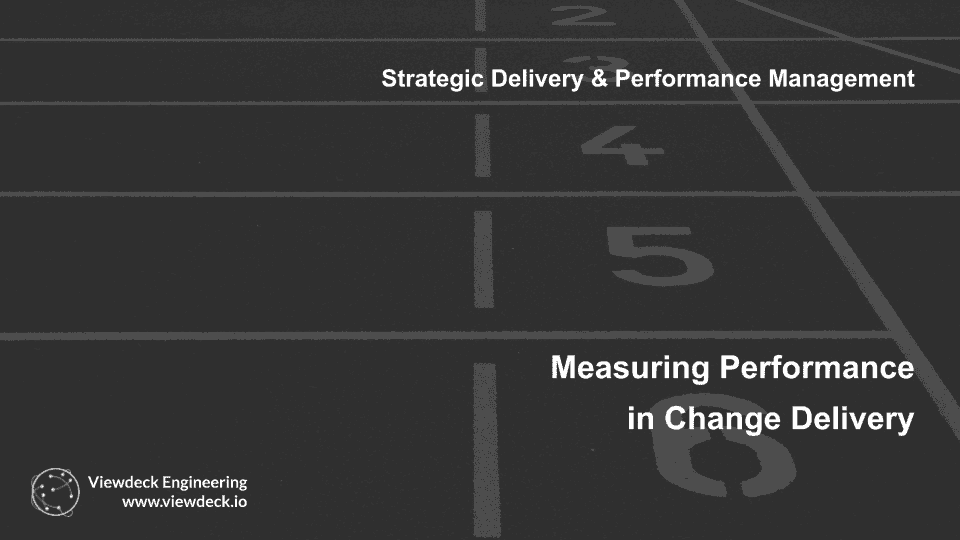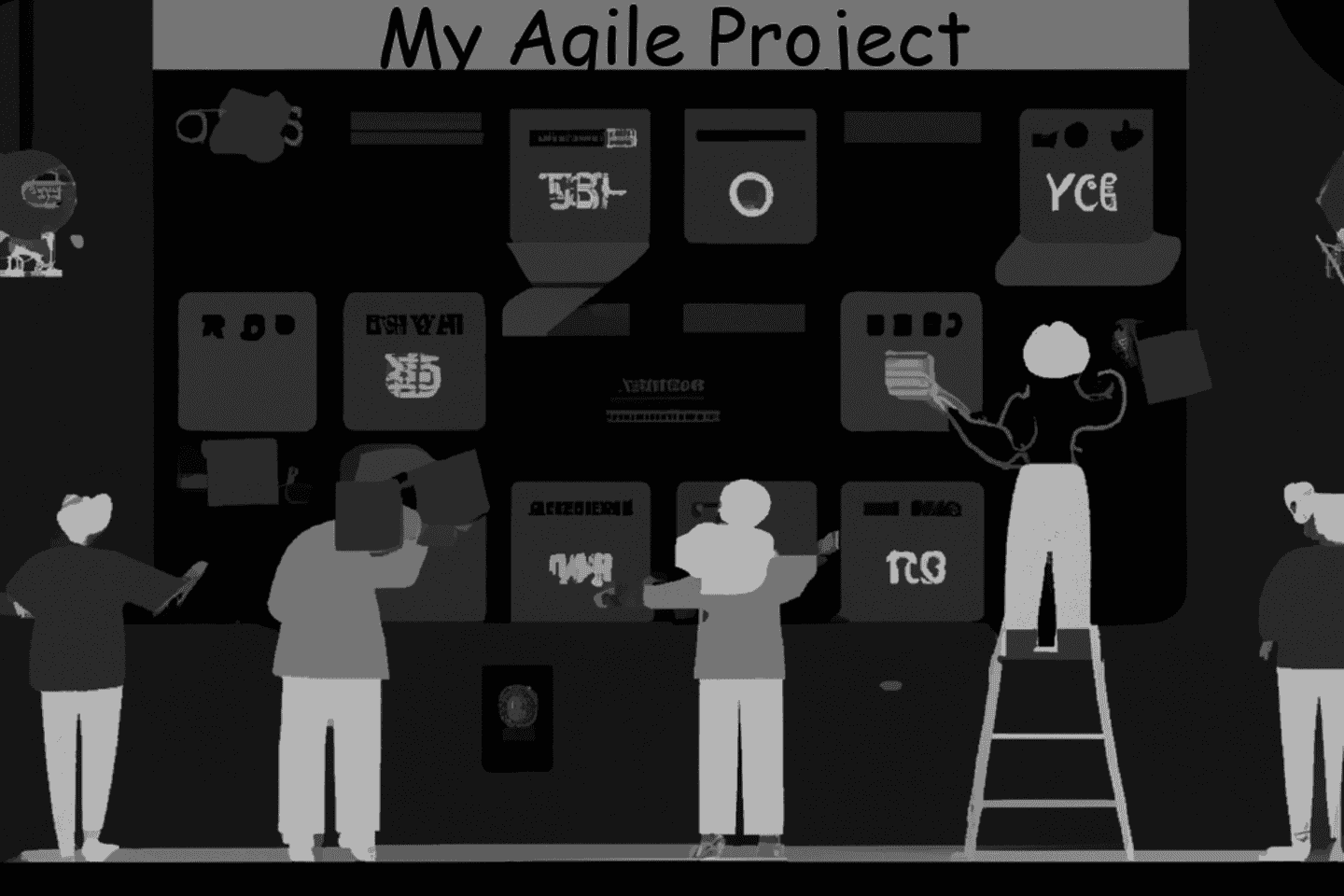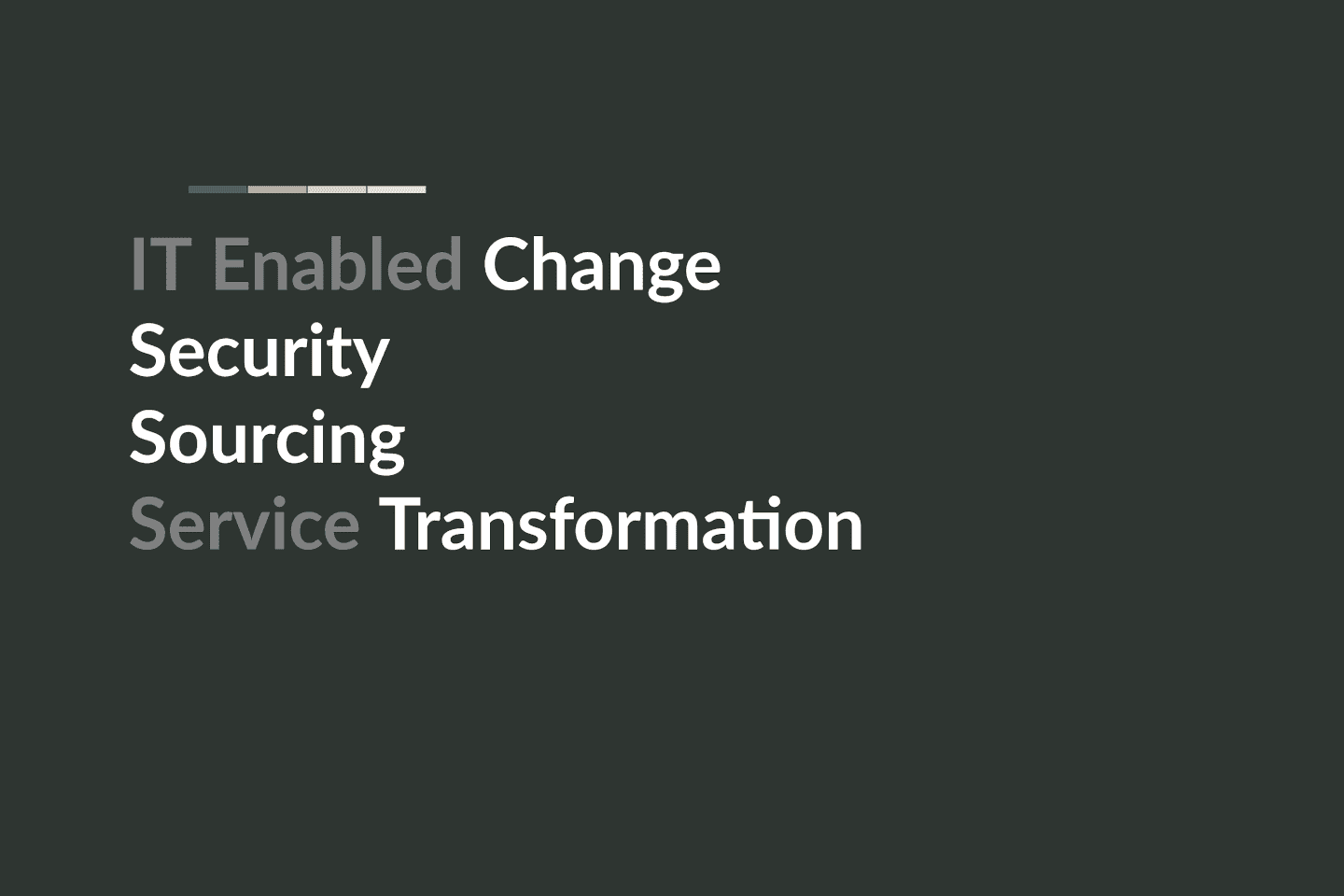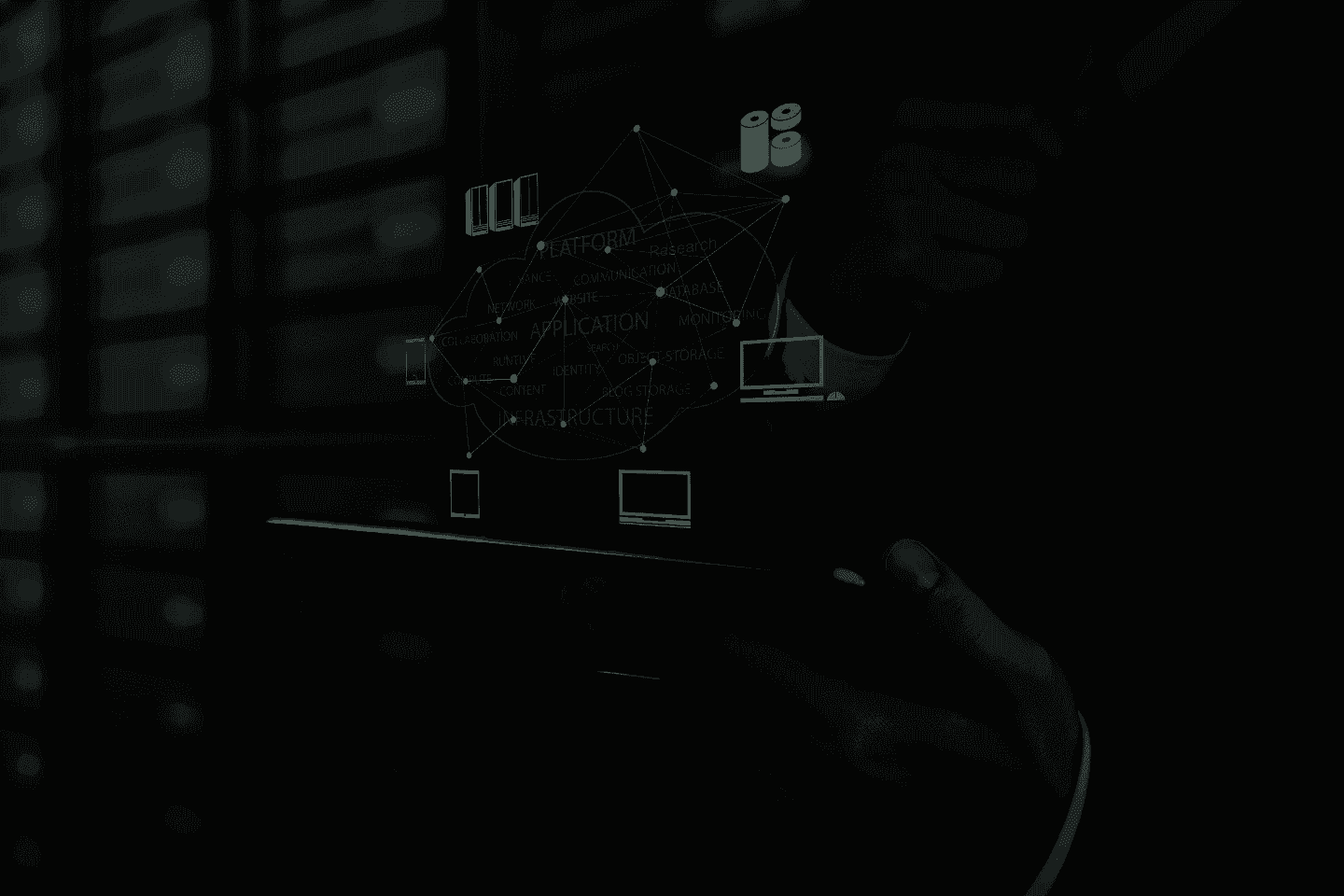The Intelligent Client Function : Structuring Demand, Managing Performance.
Drive Innovation and Change, Ensure Value for Money, Alignment with Agreed Strategy and Principles, Managing and Aligning Demand and Supply, Enabling Agility and Flexibility.
We have previously looked at Strategic Sourcing, that aims to manage the supplier base, and drive efficiency and value through motivating, contracting and managing suppliers through a range of commercial and managerial tools.
In this article we are going to introduce the concept of the Intelligent Client Function ( aka "ICF"). Sometimes called the 'Intelligent Customer, we will stick with 'Intelligent Client' label, inline with those used across wider industry and the public sector.
The Intelligent Client Function is the client side capability that co-ordinates the organisation's sourcing plan, delivery structures and ensures availability of those critical services. As part of Service Delivery, the ICF is not specifically ICT focused, but is often structured and configured to manage the myriad of software, platform and application suppliers, in complex delivery environments. Its goals are to focus capability, vendor performance, strategic risks, portfolio delivery within large enterprise or programme management. It can be a virtual concept pulling together key delivery functions like Supplier Management, Service Strategy, or a physical organisational unit that focuses on improving outcomes through building focus (=Accountability), core skills and capabilities to get the best outcomes for both operations and programme delivery.
The ICF pulls together (senior) Stakeholder Management, Sourcing Strategy, Strategic Service Design, Supplier Management, Commercial functions, and Portfolio Management, to steer complex delivery environments, to reduce risk, increase efficiency and drive the best value for money.
Intelligent Client Function Aligned to ITIL
If we take an ITIL Service Management view of the ICF, it clearly fits within the 'Service Strategy' and 'Service Design' pillars of the Service Model, supporting key portfolio level activities around managing and driving a strategic view of Service delivery. Mapping the ICF to the core ITIL functions, using a simple RASCI approach, we get a overall picture of how the ICF sits inside the service delivery organisation.
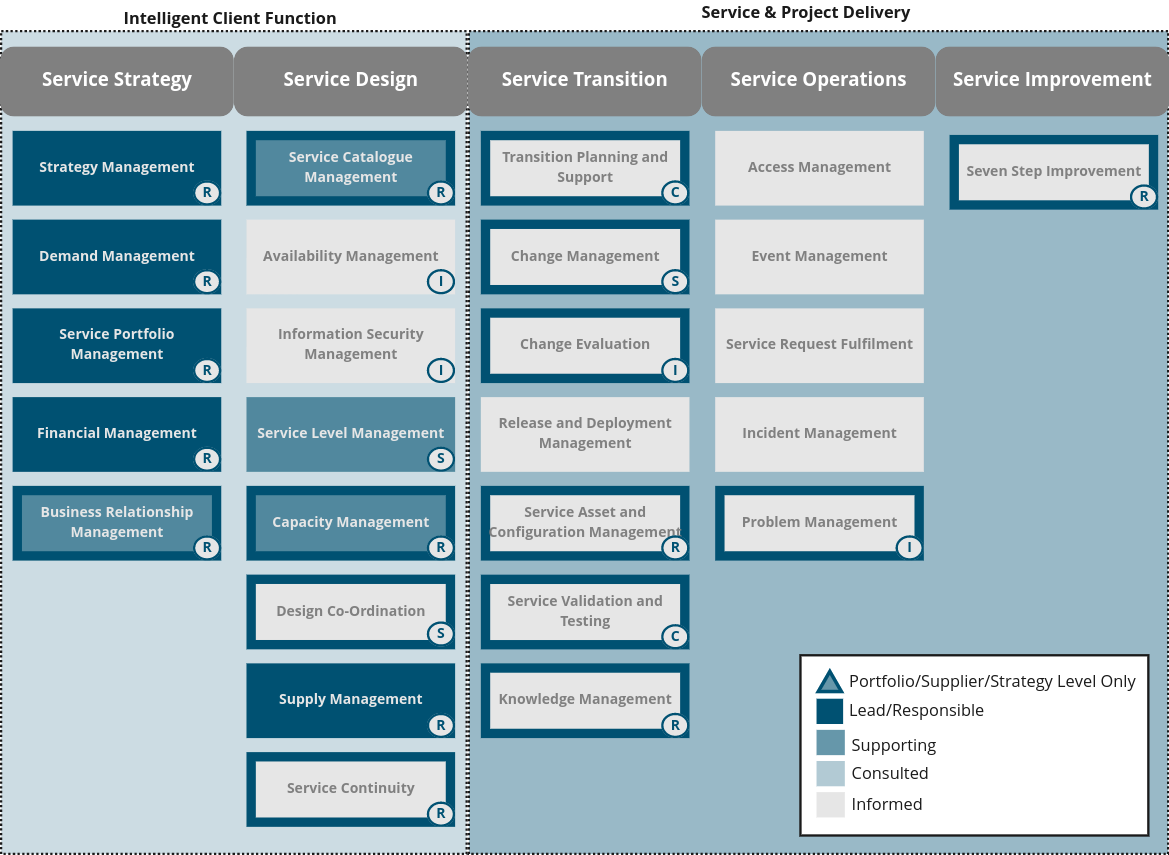
The ICF is focused on managing Service Delivery at a Portfolio perspective, coordinating between Supplier delivery, Contractual/Commercial functions and dependent business services like Continuity, Finance and Performance.
The goals of the ICF are to support the business to :
- Drive Innovation and Change: Create new products, services, and strategies that will help to stay competitive in the market and meet customer needs. This is supported by a culture that encourages creativity and risk-taking, as well as a commitment to research and development.
- Ensure Value for Money: Provide quality products or services at an affordable price. This is achieved by understanding customer needs, creating efficient processes and cost-effective supply chains, and leveraging technology to optimise operations. It is important to ensure that customers are getting the best value for their money. The ICF should manage the benefits realisation of the service strategy (including the capabilities provided by suppliers), and feed into wider programme benefits realisation activities to provide a total view to the business on the overall success and VfM for its initiatives.
- Ensure Alignment with Agreed Strategy and Principles: Ensuring that business decisions are made within the framework of the agreed strategy and principles. This includes making sure that activities are aligned with the organisation's mission, values, and objectives. It also requires ensuring that all decisions are in line with legal requirements, industry standards, and accepted best practices.
- Managing and Aligning Demand and Supply: Managing demand for products or services and aligning with available supply to ensure business need and customer satisfaction. This involves understanding customer needs, forecasting demand, optimising inventory, and managing the supply chain. It is important to have an effective system in place to manage this balance between demand and supply.
- Enabling agility and flexibility: Create a dynamic environment where the business can quickly respond to changing market conditions. This requires having systems in place that allow for quick decision-making and adaptation based on feedback or emerging trends. It also involves creating a culture that encourages innovation and collaboration between teams.
Why do we need an Intelligent Client Function?
The core objectives of the ICF will be tailored to each business and its goals, operating environment, and the delivery structures needed. Ultimately it brings focus, and responsibility to definition strategy, delivering capability (supporting demand) and ensuring quality of the capabilities needed by the business to deliver its big-change initiatives.
The following outlines a candidate set of likely Objectives, that reflect many delivery scenarios, and stand as a good basis for any environment.
-
Need to reduce capital and operational expenditure: Reduce the costs associated with maintaining infrastructure and services, as well as the costs for change, supporting projects and programmes.
-
Desire to see process improvements within the ICT/Service Delivery function: improve the processes used by service operations and programme delivery in order to increase efficiency and effectiveness (including improving or creating new processes, automation etc).
-
Leverage existing assets, capabilities and investment: Make use of existing resources, (agreements, partnerships, capabilities, skills), in order to maximise return on investment (existing suppliers, partner organisations, industry/community capabilities, marketplace opportunities)
-
Improve time to market for delivery of business initiatives: Reduce the time it takes for new products or services to be launched in order to meet business goals, and remain competitive. (Eg introducing agile practices or incorporating DevOps, Cloud, Multi-Vendor supply, 'elastic' or Framework service agreements etc)
-
Demand for ICT Services to be more productive, flexible and responsive (VfM, Efficiency and Effectiveness): Support Operations, and Delivery with changes to support value for money, while enabling quick response changing business needs. This could involve introducing new suppliers, acquiring new services, improving tools, developing knowledge base, developing shared capabilities, and standardising processes. It includes a balanced view of how to leverage suppliers for the delivery of commodity services, how to maintain key core capabilities that are critical to the delivery of the business, and how to best ensure knowledge retention/internal capability.
-
Enabling the business to focus on its core competencies: Provide specialised, experienced capability to professionally manage the portfolio of service delivery, strategic supplier management, and provide a sustainable direction and ownership for service delivery. Enable business owners to focus on their own areas of expertise, rather than being bogged down with managing suppliers, marketplace or supporting capabilities. (including outsourcing certain elements of operations or operations, introducing self-service tools).
-
De-risk Delivery by more effective utilisation of suppliers: Ensure that the business is taking advantage of their suppliers' capabilities, with the right supplier mix, to minimise delivery risks. This could include developing better processes for selecting suppliers, improving service architecture, changes to way contracts are let, and monitoring performance against SLAs.
-
Driving Responsibility and clarity of Ownership Ensure that there is clear accountability across all areas of service delivery (aligned to the Service Architecture) in order to ensure the identified successful outcomes. Introduce a system of ownership whereby there is clear roles and responsibilities all aspects of the service delivery, including availability, performance, design assurance etc. Look to align delivery, ownership and reporting across all sides of the service delivery to Outcomes Based Delivery. Working with the Design Authority, drive clear ownership across both Operations and Delivery ( including Business and Service Continuity ).
-
Improve the capability, maturity and sustainability for Service Delivery: Ensure that the right capabilities exist, continue to exist, in order to support ongoing business needs in service delivery, operations and change. Implement Service Improvement processes in both internal capabilities, managing processes and supplier delivery reduce risks, increase performance, and improve agility. This could involve introducing training programmes, establishing best practices across teams, or developing measurable KPIs that help management to evolve skills and capabilities that support the longer term business goals.
ICF within the Corporate Governance Structure.
ICF manages Demand and Supply, within the context of the Business Need. From External influences, we drive Business Strategy, that helps identify the Service Demand. The ICF supports the supply function, to help shape and delivery the future capabilities.
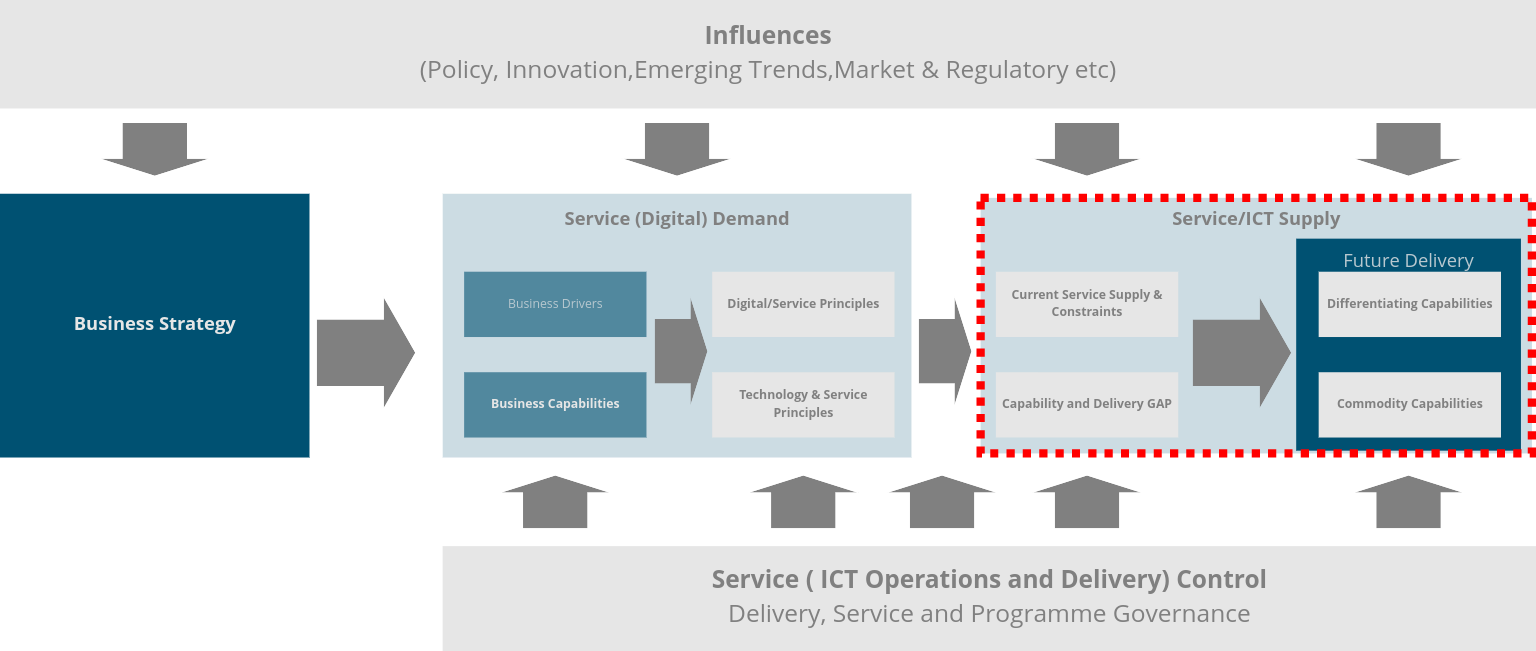
Influences: Includes both external and Internal influences that may impact one or more components of the service strategy. Need to consider and impact these influences to enable the service design to continuously support business strategy and policy delivery.
Demand is driven by business strategy and change initiatives, where key drivers are translated into (Service/ICT) Design Principles. These principles are guidelines for what the service(s) must deliver to enable & meet these business demands and should be revised inline with changes in strategy/vision delivery. The business strategy also determines the (future) business capabilities, leading to future Service/ICT needs.
Supply defines the “must-have” capabilities to deliver the services to meet the demand, comprising of capabilities, capacity and skills. They can be divided into “differentiating” and “commodity” items. Differentiating capabilities are core to the business for achieving desired competitive advantages, while commodity capabilities may be best managed through lower cost options such as ITO/BPO or Cloud. Understanding of the key constraints is important for proper planning on future service investments, and to architect the supply model.
Service Control consists of the delivery organisational and operational structure. Operational and Delivery governance defines the mechanisms, structure, rights and account-abilities for the organisation to make all Service related decisions. This enables successful strategy implementation and supports continuous Business-Digital alignment.
The Scope of the ICF
The ICF is designed to support that portfolio delivery issue. While transaction and commodity services need to be managed, we are interested in capabilities that are going to impact the deliver of business change, or ensure delivery of core business functions.
Typically the ICF would aim to take responsibility for managing demand, supply and quality for Policy, Strategic Change or high Risk/High Value Services. It would take a lead role, with responsibility to coordinate and manage the strategy, execution and ongoing management of key services. For Transformation Projects, or Projects with a higher degree of business risk, the ICF would be consulted and possibly provide a supporting function. Where there is duplication of demand, with existing capabilities that can be leveraged, the ICF would provide a "Support" to project teams to deliver a managed capability from within the eco system (Re-Use). Lower Value, Low Risk services, utilising Commodity capabilities would typically not directly involve the ICF function, leaving the delivery and management to existing service processes and commercial capabilities.

Benefits of the Intelligent Client Function
The benefits will align to the goals, and hence the objectives that the ICF are looking to deliver. The following summaries the core benefits that could be used as part of any business case, and provide measurable KSIs ( and hence realisable benefits ). Clearly they need to be aligned to the business, and using a Balanced Score Card approach tuned to provide the clarity to the business.
-
Delivery of value for money, appropriate quality services to meet business needs, with Effective Governance (Supplier/Vendor Management, Performance/Service Reporting)
-
Empowered Enterprise function that is responsive and delivers with agility and flexibility (Service Ownership)
-
Drive Innovation and Change throughout the Delivery Life-cycle (Service Design & Service Strategy)
-
Balance (Ensure) between demand and supply (Demand Management)
-
Commission, measure and manage work based on Outcomes (Service Management)
-
Enable friction-less, responsive supplier/business contracts (Service Transition)
-
Encourage/drive Partnering Behaviours with suppliers and partners (Service Improvement)
-
Implement change in the sourcing approach as the business needs or external environment changes Service Design/Agility )
ICF Value Network & Alignment to TOM.
We can consider the value of the ICF in relation to how it supports and enables delivery within the organisation, and then consider how it integrates into the operating model. The IT4IT Reference Architecture provided by the OpenGroup provides a useful framework to help understand, measure and evaluate organisational delivery structures, especially in digital service delivery.
IT4IT looks to
- Provides a vendor-neutral reference architecture that delivers value-driven improvement to business outcomes
- Accelerates the adoption and delivery of end-to-end management of Digital Products and services Ref: https://pubs.opengroup.org/it4it/3.0/standard/_preface.html
Using the IT4IT Value Streams as a reference ( see The IT4IT Functional Groups, Value Streams, and Associated Digital Product and Service Offer Backbones ) we can start to understand how the ICF relates to the key functional groups ( Strategy, Portfolio, Support and Assure ) as well as the supporting Functions that it enables, supports or drives (Financial Management, Governance, Risk & Compliance, Collaboration & Communications, Intelligence & Reporting, Sourcing and Vendor Mgmt).
With this top Level Target operating Model, (using the OpenGroup IT4IT Level 1 Functional Diagram as a reference), we can start to see how the ICF forms part of the overall delivery, and sits as part of the overall organisational digital delivery capability.
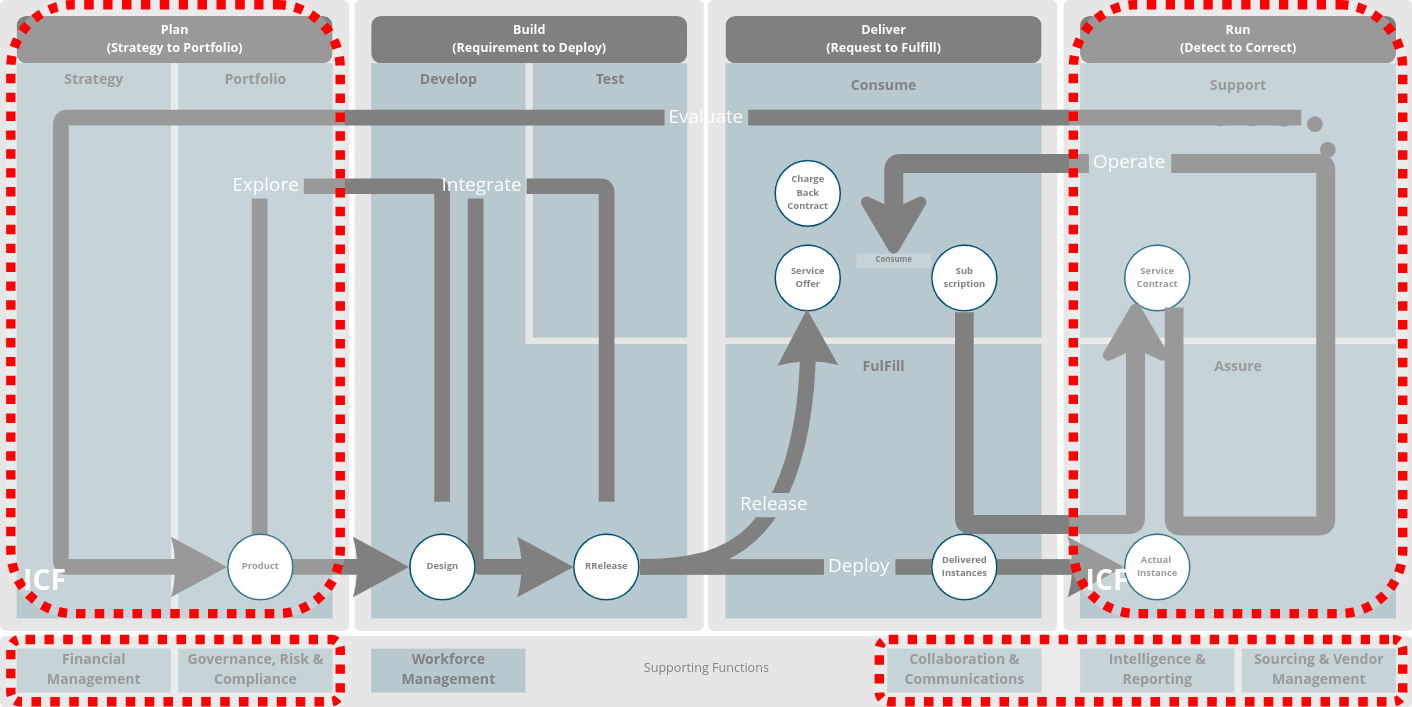 IT4IT is a trademark of The Open Group, and all IT4IT content is Copyright © 2022, The Open Group.
IT4IT is a trademark of The Open Group, and all IT4IT content is Copyright © 2022, The Open Group.
The ICF Value Network looks to explain how organisations can create and capture value in a digital, interconnected world. Value Network analysis comes from Porters original Value Chain concept, but increases focus on the inter-dependencies among these stakeholders and how their activities can create and capture value (eg IT4IT Value Network Interactions). We can develop a view of how the ICF interacts and provides value to Stakeholders and the Service Organisation.
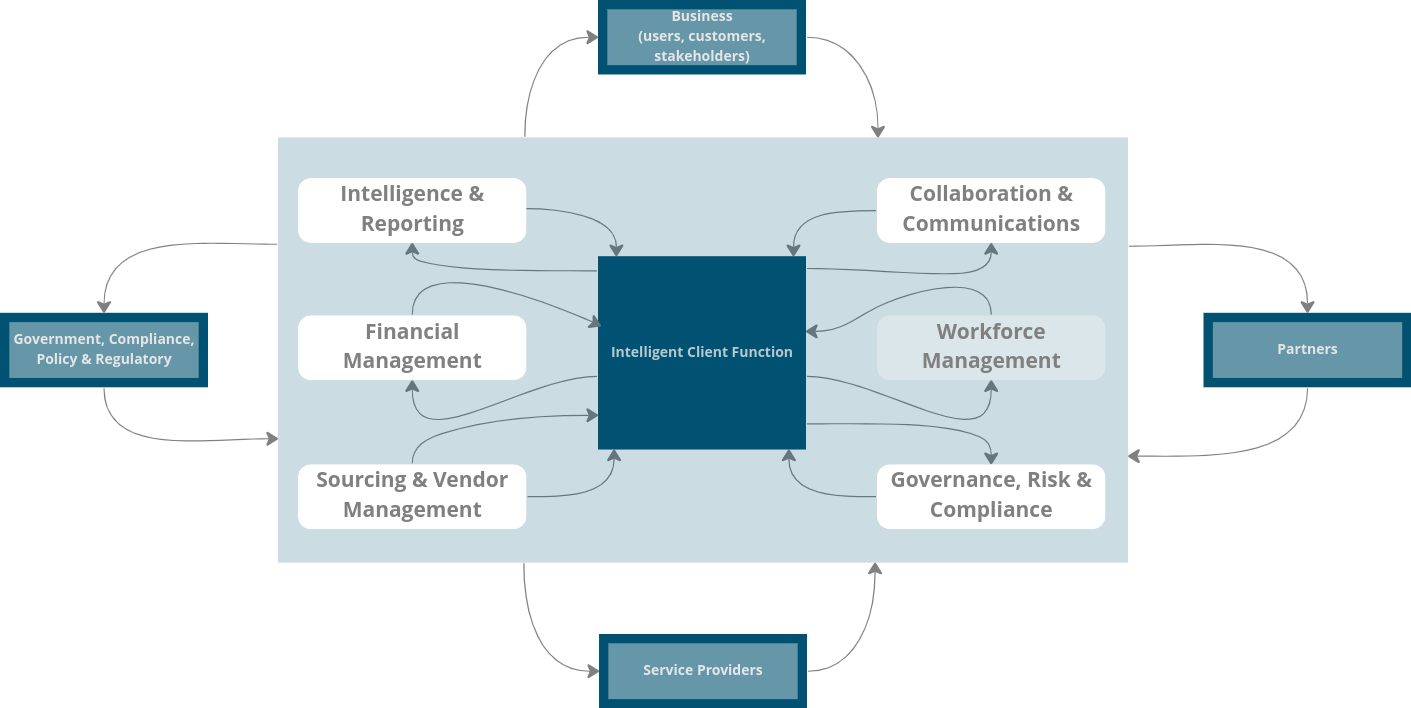
Conclusion
The Intelligent Client Function isnt appropriate in all scenarios, but in large scale complex programme delivery it can help bring focus, skills and experience to complex delivery issues. Managing multiple suppliers, with different terms, across multiple moving timelines can be difficult, especially if tackled in Silos. The ICF looks to bring that strategic delivery together, to bring both business, service management, supplier management, and programme delivery into the control and governance of those critical services at the portfolio level . The ICF can help both shield and support the business in delivering its strategic goals, reduce the risks resulting from un-managed suppliers, and provide the agility to respond to changes in requirement.
Using a service based approach to sourcing, with Vale-for-Money, Innovation, reduce delivery friction, enable Partnering, as well as driving change in approach, it can help to better align delivery to business needs.

